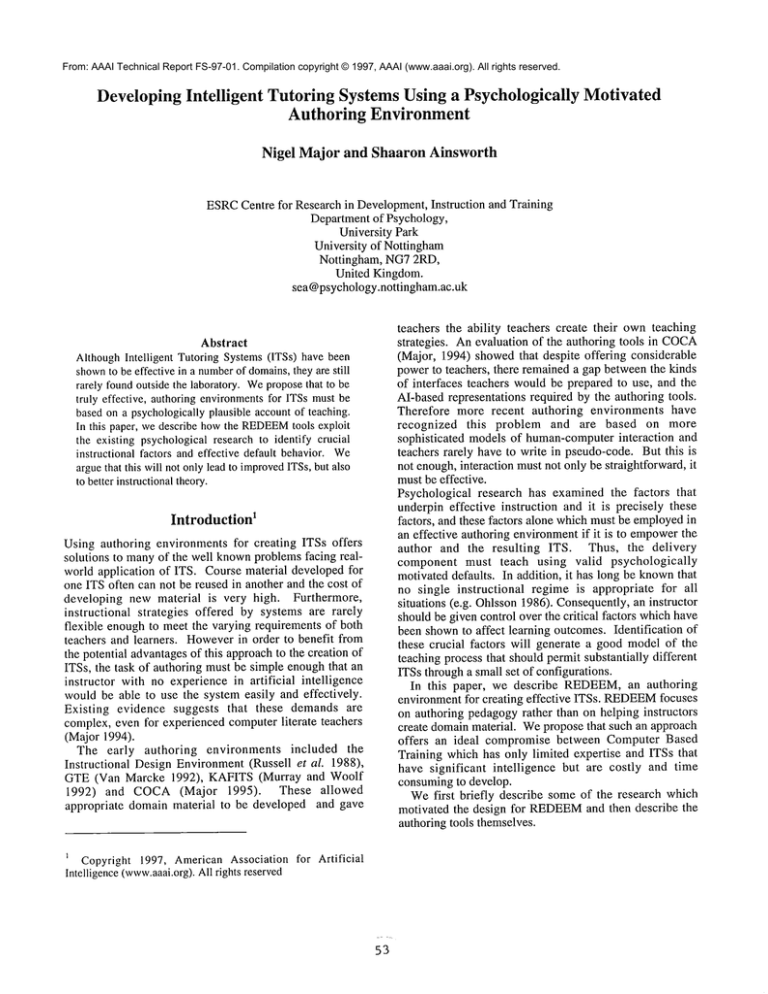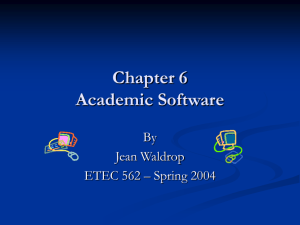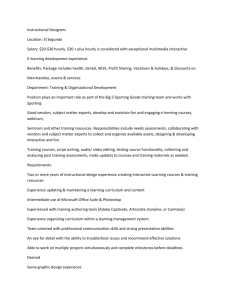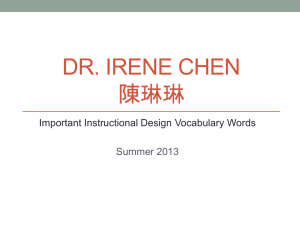
From: AAAI Technical Report FS-97-01. Compilation copyright © 1997, AAAI (www.aaai.org). All rights reserved.
Developing Intelligent
Tutoring Systems Using a Psychologically
Authoring Environment
Motivated
Nigel Majorand ShaaronAinsworth
ESRCCentre for Research in Development,Instruction and Training
Department of Psychology,
University Park
University of Nottingham
Nottingham, NG72RD,
United Kingdom.
sea@psychology.nottingham.ac.uk
teachers the ability teachers create their ownteaching
strategies. An evaluation of the authoring tools in COCA
(Major, 1994) showedthat despite offering considerable
powerto teachers, there remained a gap between the kinds
of interfaces teachers wouldbe prepared to use, and the
AI-based representations required by the authoring tools.
Therefore more recent authoring environments have
recognized this problem and are based on more
sophisticated models of human-computerinteraction and
teachers rarely have to write in pseudo-code. But this is
not enough,interaction must not only be straightforward, it
mustbe effective.
Psychological research has examined the factors that
underpin effective instruction and it is precisely these
factors, and these factors alone which must be employedin
an effective authoring environmentif it is to empowerthe
author and the resulting ITS. Thus, the delivery
component must teach using valid psychologically
motivated defaults. In addition, it has long be knownthat
no single instructional regime is appropriate for all
situations (e.g. Ohlsson1986). Consequently,an instructor
should be given control over the critical factors whichhave
been shownto affect learning outcomes. Identification of
these crucial factors will generate a good model of the
teaching process that should permit substantially different
ITSs througha small set of configurations.
In this paper, we describe REDEEM,an authoring
environment for creating effective ITSs. REDEEM
focuses
on authoring pedagogyrather than on helping instructors
create domainmaterial. Wepropose that such an approach
offers an ideal compromise between Computer Based
Training which has only limited expertise and ITSs that
have significant intelligence but are costly and time
consumingto develop.
Wefirst briefly describe some of the research which
motivated the design for REDEEM
and then describe the
authoring tools themselves.
Abstract
AlthoughIntelligent Tutoring Systems(ITSs) have been
shownto be effective in a number
of domains,they are still
rarely foundoutside the laboratory. Weproposethat to be
truly effective, authoring environmentsfor ITSs must be
basedon a psychologicallyplausible accountof teaching.
In this paper, we describe howthe REDEEM
tools exploit
the existing psychological research to identify crucial
instructional factors and effective default behavior. We
arguethat this will not onlylead to improved
ITSs, but also
to betterinstructionaltheory.
1Introduction
Using authoring environments for creating ITSs offers
solutions to manyof the well knownproblemsfacing realworld application of ITS. Course material developed for
one ITS often can not be reused in another and the cost of
developing new material is very high. Furthermore,
instructional strategies offered by systems are rarely
flexible enoughto meet the varying requirements of both
teachers and learners. Howeverin order to benefit from
the potential advantagesof this approachto the creation of
ITSs, the task of authoring must be simple enoughthat an
instructor with no experience in artificial intelligence
would be able to use the system easily and effectively.
Existing evidence suggests that these demands are
complex, even for experienced computerliterate teachers
(Major 1994).
The early authoring environments included the
Instructional Design Environment(Russell et al. 1988),
GTE (Van Marcke 1992), KAFITS (Murray and Woolf
1992) and COCA(Major 1995). These allowed
appropriate domain material to be developed and gave
Copyright 1997, AmericanAssociation for Artificial
Intelligence(www.aaai.org).
All rights reserved
53
Psychologically
Motivated Instruction
Two important aspects in the design of an ITS are
decisions about the subject material and the teaching
sequence (i.e. what to teach) and the nature of instruction
(i.e. howto teach).
What to teach
One major issue for the REDEEM
authoring tools and the
resulting ITS is the decision about how to sequence
instruction within a given learning domain.There is rarely
a single fixed sequence of learning routes through a
domain that will prove to be optimal for all learners
(Resnick 1976). Investigations into aptitude x treatment
interactions (ATIs) suggest that to maximize learning
outcomes, authoring environments should provide for
multiple waysof structuring course material.
A number of different aspects of REDEEM’s
model of
teaching provide for this flexibility.
Teachers can
configure a wide variety of routes through a course. These
mayrepresent different pedagogical views. For example,
teachers may suggest that the ITS first describe the
theoretical frameworkbefore presenting specific examples
or could on, other occasions, expose students to a number
of relevant examples before introducing any general
principles. While providing this flexibility,
REDEEM
monitors that the routes through the course remainsensible
by allowing teachers to specify the pre-requisite
knowledgenecessaryfor a particular unit and ensure that it
has been previously taught. Additionally, in certain
circumstances, teachers mayprefer to let students choose
their own learning sequences. Hence, REDEEM
provides
for varying degrees of control to be given to the student.
How to teach
There is a great deal of evidence that different types of
students benefit from different instructional regimes (e.g.
Cronbach and Snow 1977; Kyllonen and Shute 1989).
Consequentlyauthoring systems should be able to support
a variety of instructional strategies. The different
dimensions of instructional strategy provided in REDEEM
allow different ITSs to be produced. This behavior is
crucial for allowingteachers to achieve specific objectives.
Differences
in instructional
variables
can be
accommodatedwhen ITSs are capable of being configured
to support different lessons and students. Particular
categories of students (e.g. those high or low in incoming
knowledge) could experience different instructional
regimes. The same student could use the ITS for different
purposes and hence would require alternative kinds of
support, for example, first exposureto the material versus
revision. In addition, REDEEM
based ITSs can routinely
apply a variety of teaching styles during a single lesson.
To consider just one dimension from REDEEM’s
strategy authoring, the amount of learner control has
been somewhat contentious in the design of ITSs with
54
existing systems varying betweenhigh learner control (free
discovery environments, Logo) and heavily directed
instruction (e.g. model-tracing tutors such as Anderson’s
Lisp tutor,
Anderson and Reiser 1985). Yet the
relationship betweenlearner control and learning outcomes
is not a simple one. The success of high learner control
depends on factors such as prior knowledge, motivation,
instructional goals and cognitive skills (Steinberg 1989).
Oneof the more robust findings from the research on ATIs
is that learners with lower aptitude should be given less
control over howthey learn.
Furthermore, REDEEM’scourse material authoring
allows teachers to make statements about the perceived
level of difficulty of each page in the domain. The shell
wouldaim to offer pages that fall within the ideal level of
difficulty:
i.e. in the learner’s zone of proximal
development, (Vygotsky, 1978). This is the region
activity in which learners can perform successfully given
the aid of supporting context. Allowingthe ITS to choose
material at different levels of difficulty allows us to cater
for a wider range of understanding.
Our approach allows one ITS to employ multiple
teaching styles. This allows for muchgreater flexibility of
teaching than is traditionally
the case in ITSs. In
REDEEM,
teachers are allowed to configure different
teaching strategies directly and describe, using a simple
interview tool, when they would change some aspect of
their strategy in response to a learner’s performance. The
resulting
ITS can adapt both the form of (macroadaptation) and the content of (micro-adaptation) teaching.
Such behavior has been proposed as necessary for
successful teaching by both artificial and humanteachers
(Woodet al. 1976; Ohlsson1986).
The REDEEM
Software Tools
The REDEEM
tools consist of three main pieces of
software: the courseware catalogues; the authoring tools
and the instructional
shell. This software has been
developed in Asymetrix Multimedia ToolBookand runs on
Windows3.1 or higher. An instructor uses the authoring
tools to describe courses, construct teaching strategies and
identify students. The shell uses this knowledge,together
within its owndefault teaching knowledge,to interpret the
courseware in such a way as to deliver intelligent
instruction.
Courseware Catalogues
The domain material in REDEEM
is provided by a
courseware catalogue. Coursewareconsists of pages from
computer-basedtraining developed in a standard authoring
package, Asymetrix Multimedia ToolBook. These are not
built within REDEEM
but are used to provide the basic
pre-prepared subject content. Consequently,this limits the
flexibility of the resulting ITS to someextent, but it does
allow greater reusability.
The ideal courseware for
REDEEM
presents discrete pages of material showingthe
MultimediaToolBookCBTEdition - GENET1C.TBK
Page Help
A
3ody cell
~ B is
in father
witha
pairof
~<~
\
genesfor \ i,./~#’ X,~
brown \’--~ eacnsperm
eyes
~ has a gene
Gametes~ for brown
!Pagename
....
inheritance
~[ eyes
Figure 1. Describing a page of course material using
different aspects of the domain at varying levels of
difficulty.
Weare currently testing REDEEM
using a
genetics course for 15 year old high school students, built
with the assistance of a their biology teacher. The material
covers aroundt2 hours of teaching time and includes a full
range of multimediapresentations, with still photographs,
text, graphics, sound, animationand simulation.
they have developed with appropriate pages in the
material. Rapidelicitation of course features is ensured by
graphical manipulationof sliders (see figure 1 for a page of
course material and the authoring tool).
In addition to any interactive problem solving tasks
already present in the course material, teachers can
prescribe appropriate questions. Question templates allow
teachers to define questions and specify answers and give
up to five hints for each question that follow the principle
of contingent instruction. The shell will monitor the
student’s performance on these questions to help inform
the student model.
Pages can also be combined into sections. Material
which addresses similar topics can be grouped into one
block for delivery even if the relevant pages are distant
within the courseware catalogue. Relations between
individual pages can also be specified. Thus, pages which
are analogous can be related and pre-requisite knowledge
can be described. All of this information is used to
construct a semantic network of the domain. This
description is used by the shell to implement teachers’
preferred routes through material and to make default
decisions about adapting content.
Authoring Tools
REDEEM’s
authoring environment consists of five main
tools. These allow the teacher to describe the different
courses, to construct teaching strategies, to categorize
students, to assign different strategies to different student
categories and to describe howteaching should be refined
during a lesson.
Describing Course Material. To begin the authoring
process, course material must be described. This is the
most time-consuming aspect of the authoring task, but
need only be done once and could be shared amongst
different teachers. For each domain page, the teaching
material is classified upon a number of dimensional
ratings. Hence,each page is rated as to whetherit is likely
to be familiar to the students, newor introductory. These
dimensions were developed in consultation with teachers
and in reference to the research literature. In addition,
teachers can associate non-computer based tasks which
55
~I
REDEEM
--
I
I~
--
l~.l=N.,.,[,y.],,--(~I,~i.,[.=.~l~..~’m
Strateqv
’"-~:~
~‘~:~‘~:~‘~;~‘~-~‘~:~i~‘}}~
Ii
Teachimlstrategy
Teacher cho ce~ Jk
1
I
I
I
~tudent choice
¯
~ ,tk l
I
i Tests interspersed~ ~ .
,
] Jk l
! Stad genera ~
~
~est together
)Lots ofintenuptio.~
~ointerruption
=eFtaSkSi)
z;,,~r’~°~comp
......
)
l
,A,)Icompute~
i
i
I
ml
’I
I
~,artepecific
~ Teachinq
~Presentation
--~
) ~ Analogy
i
! Problem sohring i
J
)f Testing""
~"
i)
i
~
~_j -Fill- mthe blank
.......
-_
~
7 Grt’U:;hiU:a
i
i
!
i
)
~l
Figure 2. Screen showingteaching strategy authoring
Developing Teaching Strategies. The second important
componentof the authoring task is the definition of a
number of teaching strategies
to provide the basic
repertoire of the teaching shell. Figure 2 shows the
definition of a strategy that has been called practice
Different instructional principles can be embodied in
various strategies by manipulatingthe sliders. Each slider
in Figure 2 has three discrete positions that result in a
different style of teaching. For example, movinga slider
from having tests interspersed to having tests together will
meanthat the positioning of questions changes from after
every page, to after every section or at the end of the
course. Similarly, selecting high teacher choice ensures
that the shell will choosewhat it considers to be the most
appropriate page for the student, selecting high student
control leaves this decision completelyto the learner and at
an intermediatestage the shell offers the student a selection
of its most preferred pages. A number of different
teaching strategies have been developed for REDEEM.
Teachers are free to use these, edit strategies or develop
completely new ones of their own using the specified
dimensions.
In addition, the course material itself may support
different teaching styles so that, if, for example,there are
problemsolving activities present in the course material,
the shell will be directed to prefer units that contain them
56
when the problem solving style is selected. Selecting
teaching by analogy will ensure that the shell choice of the
next page will take account of any analogous relations to
the current page. The testing styles inform the shell that
the teacher prefers questions to be asked in certain ways,
such as multiple choice or fill in the blank.
Categorizing Students. Students can be categorized into
a set of author-definedcategories. The teachers can specify
these at any degree of granularity ranging from the whole
class to an individual child (see figure 3). Thesecategories
to determine the most appropriate strategy at any given
momentduring teaching. The categories can either be
fixed through the session or if the teacher selects
performance related categories, then the validity of
categories
can be evaluated against a student’s
performance.If so, the shell will automatically change the
category as the overall standard of the student (as defined
in the shell’s student model)changes.If this occurs, a new
teaching strategy will commonlyresult. Alternatively,
these categories could be used to represent dimensions
other than performance, such as learning styles or degree
of literacy,
numeracy. REDEEM
uses these student
categories, as well as information gained during a student’s
interaction with the shell, to modify its instructional
behavior.
Figure 3. Screen showingdescribing students.
about whento increase learner control by specifying that
whenthe student’s performanceimprovesto a certain level
they may be given more control. They can also can
describe preferences about when to change the amount of
teaching and testing and what factors wouldinfluence their
decision to change the topic that is being taught. All of
these dimensions can be fixed in the shell or subject to
change as the teacher chooses. Figure 4 shows one of the
interview screens.
Strategy Refinement. Particular teaching strategies can be
assigned to the student categories. Thus if a student
changes category, the REDEEM
shell may also change the
waythat it teachers that student. In addition to this facility,
teachers can describe the circumstances under which they
wouldprefer to see the shell’s teaching behavior change.
This tool leads the teacher through a numberof multiplechoice questions, eliciting
information about the
circumstances in which particular aspects of the current
strategy might change. The teacher can make decisions
REDEEM
I
..............................
Whatwoulinfluence
d
yourdecision
to
test?.
t
You’dbe more
likely to test in whichsituations?
[] Newpage
[] Studentdoing well [] Studentknowsthis well
[] Studentdoing okay [] Studenthasseenthis
[] Midsection
[] Studentdoingbadly [] Studenthasnot seenthis [] Finishedsection
17 Just taught
[] Contentis hard
[] Contentis average
[] Just tested
[] Just summarised [] Contentis easy
Figure 4. REDEEM
eliciting
knowledgeabout strategy refinement
57
knowledge is used to alter the rules for making these
decisions about teaching. In order to achieve macro-level
adaptation, the modelof the teaching strategy used at each
cycle of interaction with the student will not necessarily be
the same as the modelsused in the previous or subsequent
cycles. This is yet to be fully implemented, but it is
proposed that the shell will use knowledgeelicited in the
authoring tools to offer more fine-grained changes of
strategy during run-time instruction.
ITS Shell
The ITS shell runs the ITS by delivering the course
material according to the information provided from the
authoring tools in combination with its predetermined
defaults.
Delivering AdaptiveInstruction. Adaptive instruction is
achieved in the shell using teacher’s strategy description
and the semantic network created from the teacher’s
descriptions of the course material. There are a numberof
tutorial actions available to the shell. The first is to
choose appropriate domain material, for example should
the next page be more general, less familiar, contain a
problem solving task, and have any pre-requisites been
mastered. The delivery of any non-computerbased task is
monitored. Students are told when to choose such an
activity and cannot proceed until they have done so. The
shell selects the next tutorial activity by choosingbetween
presenting newmaterial or by selecting an appropriate test
by monitoring whenthe teacher has requested that testing
should take place and howmanyquestions they prefer this
student to answer. The shell also monitors students
performance on questions offering help when in a
contingent fashion if the teacher has so requested. The
shell also monitors whether it is appropriate to hand
control over someof these decisions to the student.
Default Tutorial Behavior. The second way that adaptive
teaching is achieved is through defaults in the shell. The
rules that govern this behavior were generated from two
sources - commonlyheld principles of instruction that
were gathered from teacher’s
in interviews
and
experimental results on instructional design. Such rules
include preferences for easy and for introductory material
whena student is starting a new section, more difficult
material whenthe student is judged to be performingwell.
Psychological principles include those generated from
contingent instruction (Woodet al. 1976) which determine
the help students receive. This states that whenstudents
are failing then offer more help, if they are succeeding,
then offer less help.
Student Model. REDEEM
employs a simple overlay
model. The values of the model change over the course of
a session as students see newmaterial and as they answer
questions. The basic course material unit being modeledis
the page. Dependingon the nature of the material, this
basic unit could correspond to an individual declarative
fact, or to a step of a procedure.
Student History. The shell maintains a student history in
addition to the student model. It keeps a trace of all
modulestaken, including pages visited, questions that were
asked and their answers, numberof hints offered, scores
and time on tasks. This history is sufficiently detailed that
it is possible to recreate a student’s session artificially.
This information is used for two primary purposes - it
serves as the basis of the report given to an instructor and
provides information for research purposes.
Strategy Refinement. Whennecessary, meta-strategic
Further
Uses
of
REDEEM
We have discussed how psychological
theories of
instruction can form the basis of the development of
authoring environments for ITSs. However, there is
another connection that can be exploited between
psychologyand ITS. At present, we are still searching for
a sufficiently general theory that can provide a basis for all
the design decisions that have to be made to construct
working systems.
By ensuring that the dimensions available in REDEEM
are those which research has identified as important in
producing effective teaching, we are in a position to
confirm or falsify these claims. This is because authoring
environments can easily keep domain material constant
while at the same time changing instructional behavior so
as to investigate its effects in relation to specific teaching
objectives and specific types of students scientifically.
Thus, the relationship between psychologyand reusable
ITSs should be a symbiotic one. Current research can
inform the design of ITSs, which can then be used to test
the theories embeddedwithin it, which in turn can inform
developing theories of instruction
and learning.
Experiments using authoring environments should provide
cleaner results than those found in the past as they allow
different teaching styles to be applied consistently and to
the same course material, thus eliminating other sources of
variance. However, such research will always be time
consumingand costly due to the time needed to run well
controlled experiments. REDEEM
does offer a partial
solution to this problemby substantially reducing the time
needed to implementdifferent ITSs.
Summary
This paper has described the REDEEMauthoring
environment. We have argued that by exploiting the
relationship between psychological theories of learning
and instruction and authoring environmentsmore effective
instructional tools result. Workconducted in schools will
be able to showwhether such an approach is justified by
exploring whether including teachers in ITS design does
result in more successful learning outcomes. In addition,
we proposed that this relationship was not uni-directional
but that theories of instruction could be enhancedby the
results of theoretically motivated experiments performed
with such an authoring environment.
58
Acknowledgments
The work was supported by the Economic and Social
Science Research Council (ESRC)at the ESRCCentre for
Research in Development, Instruction and Training. The
authors would like to acknowledgeall the other members
of the Centre for providing a stimulating and supportive
atmospherein which to conduct research.
Address
for
Correspondence
Correspondenceshould be sent to Dr. Shaaron Ainsworth,
ESRCCentre for Research in Development, Instruction
and Training, Dept. of Psychology, University Park,
University of Nottingham, Nottingham, NG72RD, UK
References
Anderson, J.R., and Reiser, B.J. 1985. The LISP Tutor.
BYTE,10(4): 159-175.
Cronbach, L.J. and Snow, R.E. 1977. Aptitudes and
hlstructional Methods. NewYork: Irvington.
Kyllonen, P. C., and Shute, V. J. 1989. A Taxonomyof
Learning Skills. In Ackerman,P. L.; Sternberg, R. J. and.
Glaser, R. eds. Learning and Individual Differences:
Advances in Theoo’ and Research. NewYork: Freeman.
Major, N.P. 1994. Evaluating COCA- What Do Teachers
Think? In Proceedings of the World Conference on
Educational Multimedia and Hypermedia - EDMEDIA
94.
AACEPress.
Major, N.P. 1995. Modelling TeachingStrategies. JoutTtal
of Artificial Intelligence in Education,6:117-152.
Murray, T. and Woolf, B. 1992. Tools for Teacher
Participation in ITS Design. In Frasson, C.; Gauthier, G.
and McCalla, G.I. eds. In Proceedings of Intelligent
Tutoring Systems92. Berlin: Springer Verlag.
Ohlsson, S. 1986Someprinciples of intelligent tutoring.
Instructional Science, 14: 293-326.
Resnick, L. B. 1976. The Nature oflntelligence. Hillsdale,
N.J.: LEA
Russell, D.M.; Moran, T.P. and Jordan, D.S. 1988. The
Instructional Design Environment.In Psotka, J.; Massey,
S.A. and Mutter, A. eds. Intelligent tutoring systems:
Lessons learned. Hillsdale, NJ: LEA.
Steinberg, E. 1989. Cognition and Learner Control. A
Literature Review.Journal of ComputerBased instruction,
16(4): 117-121.
VanMarcke, K. 1992. Instructional Expertise. In Frasson,
C.; Gauthier, G. and McCalla, G.I. eds. In Proceedings of
Intelligent Tutoring Systems92. Berlin: Springer Verlag.
Vygotsky, L.S. 1978 Mind in Society: The Developmentof
Higher Psychological Processes. Harvard University
Press, Cambridge: MA
Wood,D.J.; Bruner, J.S. and Ross, G. 1976 The Role of
Tutoring in ProblemSolving. Journal of Child Psychology
and Psychiatly, 17(2): 89-100.
59






